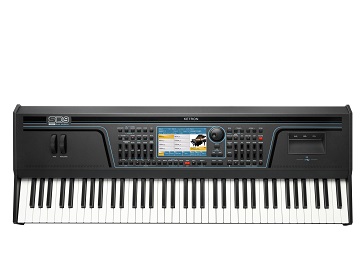 |
 |
 |
 |
 |
 |
#463154 - 12/15/18 10:12 AM
 Re: Live Drums vs Audio Drums
[Re: IMMusic_Curt]
Re: Live Drums vs Audio Drums
[Re: IMMusic_Curt]
|

Senior Member

Registered: 03/02/06
Posts: 7143
|
Hmm - An exciting challenge. I found this in the manual:
You can create User Audio Drums (Wave 44,100, 16-bit) using specific Audio Editor Software, or by importing User Audio Drums which were already created for the AUDYA series keyboards.
Whatever the origin of these files is, the SD9 Pro can "locate" and manage them through the DRUM part of the Modeling feature. In order to be properly recognized and utilized, these audio files must have the following name structure and assigned as such:-
That section of the manual goes on to describe how to name the files for the different parts of a style. I'm thinking you could take a loop that you like in Logic, bounce to a wav, name it as a fill, beak, arranger part "A," "B," etc. to make the SD90 happy. The only thing is that would be using the audio in the loop vs. what is in the SD90. Would that matter? In addition to Logic shipping with audio loops, it also ships with a number of MIDI loops that you could work with. I'll also mention another interesting feature in Logic if you haven't tried it. It's called "Drummer". By moving various sliders and turning knobs, you can influence how complex a pattern it will play. There are various genres to pick from when you start. Same thought, if you find something you like, bounce it to a wav and transfer over to the SD90 and work with it in the Modeling feature.
It just started to rain, and the wife is out shopping with her sister - Maybe I'll mess around a little with this. Sounds like FUN! Thanks, i have a dowloaded manual somewhere And yes drummer in logic and mainstage is the coolest drum app to be found.. Might be fun to get it in sync with some style or launchpads... It will be my main goal to make much more use of the vst collection and mainstage/logic/maschine, in combination with the kronos or modx..(2 setups)
|
|
Top
|
|
|
|
|
 |
 |
 |
 |
 |
 |
 |
 |
 |
 |
 |
 |
#478483 - 10/22/19 11:19 AM
 Re: Live Drums vs Audio Drums
[Re: stkeys]
Re: Live Drums vs Audio Drums
[Re: stkeys]
|

Moderator

Registered: 03/21/01
Posts: 3606
Loc: Middletown, DE
|
Live Drums/Grooves and Live Audio Drums are created the same way ... a drummer playing an actual drum set. Differece is ... Live Audio Drums are not tuched once created - they are simply streamed as audio (*.wav) when used so styles with LIVE means 18 audio wave drums are assigned to each of the 18 arranger parts (Intro1, Intro2, Arranger A, B C ... etc).
This method gives you the BEST LIVE FEELING AS YOUR DRUMMER created it ... but also offers the LEAST CONTROL/EDITING capability as you are dealing with exclusive wave/audio files.
For Live Drums/Grooves, the recorded data is further treated/scliced into sections so that they (the sections) are triggered via MIDI. This type of kit allows for some kind of CONTROL and re-arrangement without loosing too much LIVE FEEL as you are dealing with wave files but slices/segments which individually can be controlled to some extent.
MIDI drums (as used by most other arrangers) are created as thus:- Drummer sits on a drum kit, sound guy says play KICK drum, he plays the kick and that is recored as "KICK.wav", next they say play the snare soft, drummer plays snare and it is recorded as "SNARE-soft.wave", other variation of the snare recorded as "SNARE-med.wave" and "SNARE-hard.wav" ... etc and drummer goes through entire drum set, and repeats this for different drum kits (or in the case of TECHNO, DANCE ... etc, samples are purchased or created in the studio). Now all these samples are put together under various drum sets and stored in the ROM/Wave table of each instrument (KETRON, YAMAHA, ROLAND) ... etc and the samples are 'triggered/recalled' by the style or Midifile or sequencer ... etc as needed. Because these are individual samples, you have more control over volume, reverb.. etc of each INDIVIDUAL notes, more flexibility to create your own drum tracks by triggering as needed ... etc but you LOOSE the LIVE FEEL of the drummer.
Hope this better explains it.
Thanks,
|
|
Top
|
|
|
|
|
 |
 |
 |
 |
 |
 |
|
|

